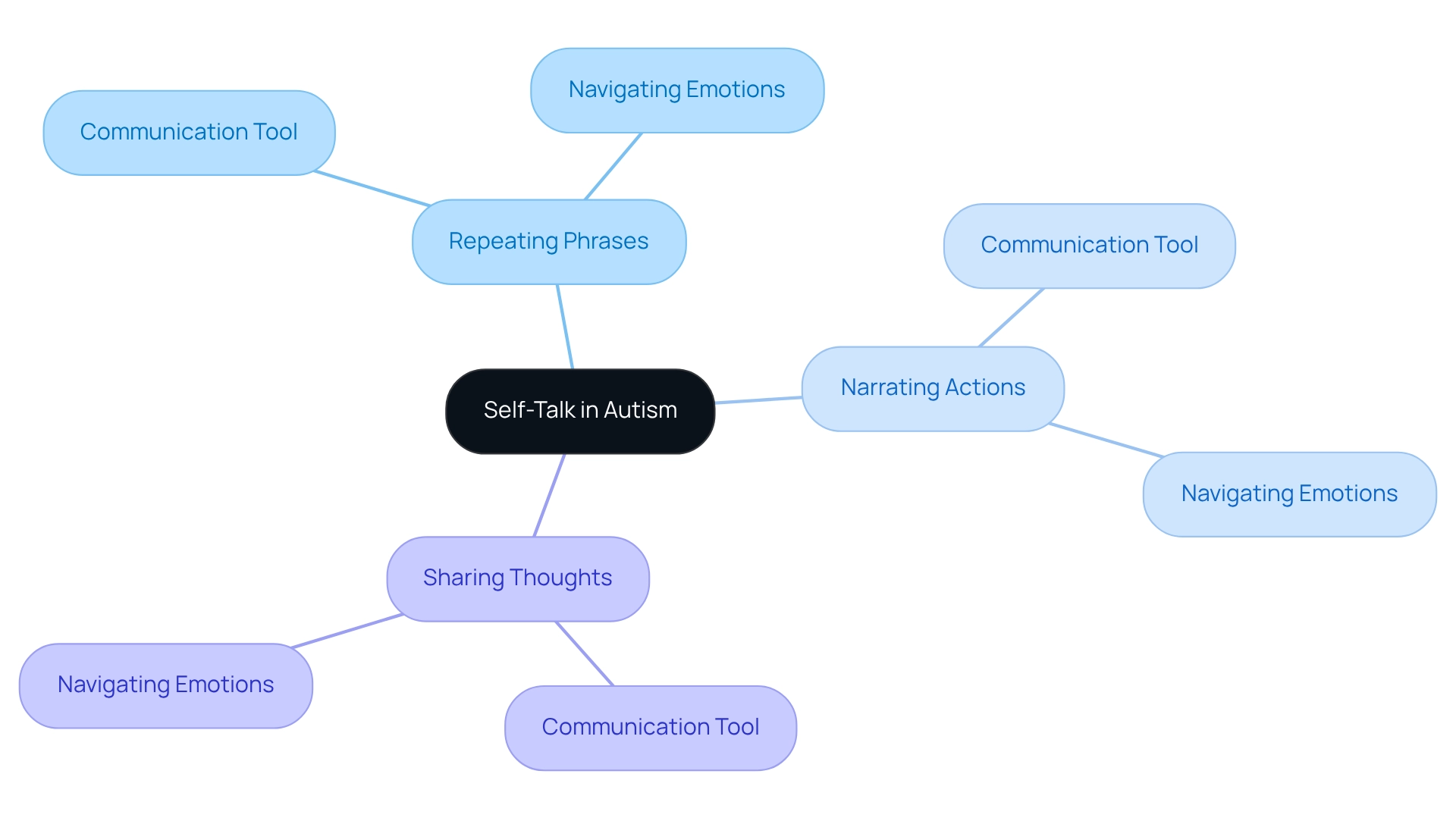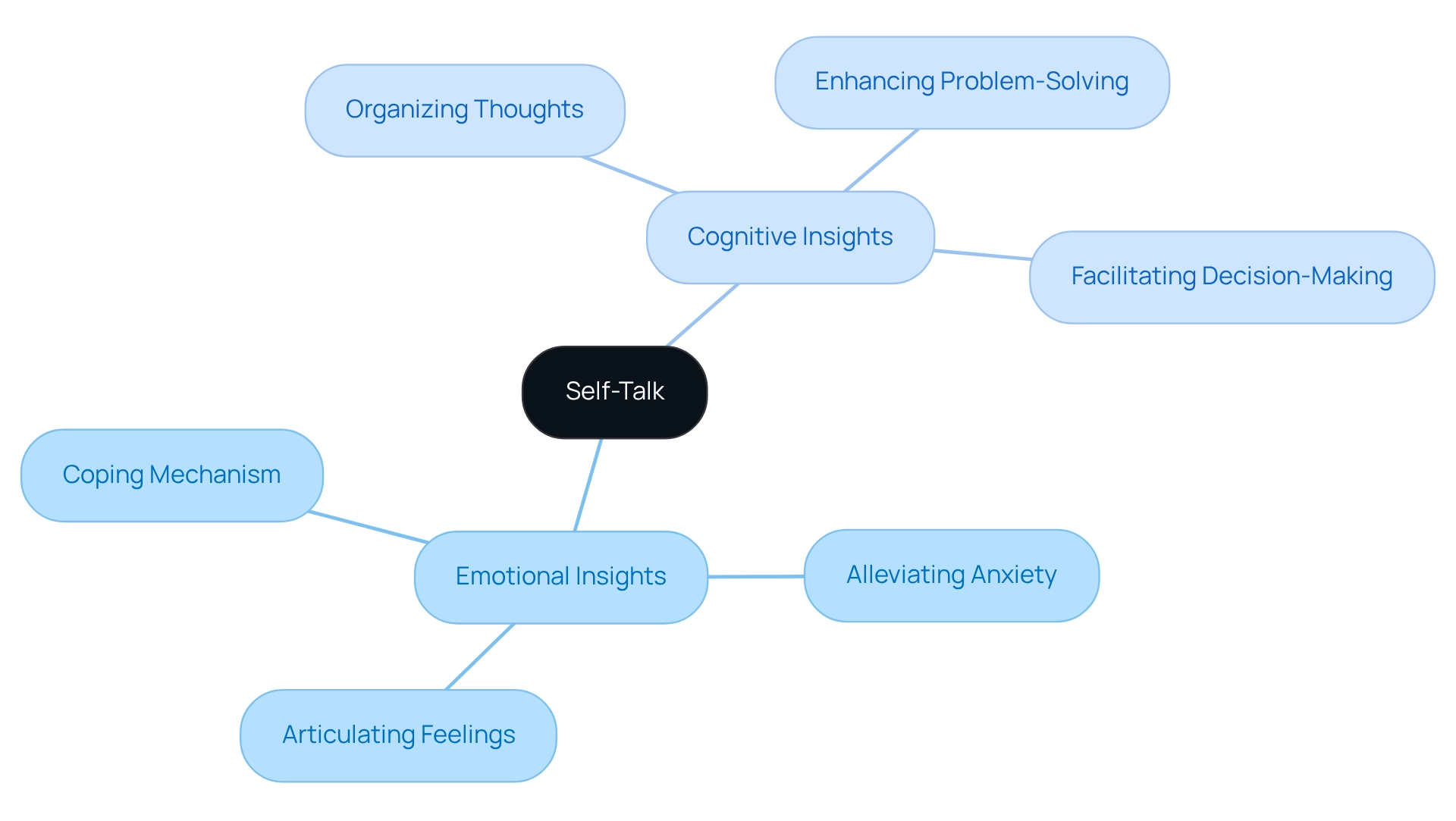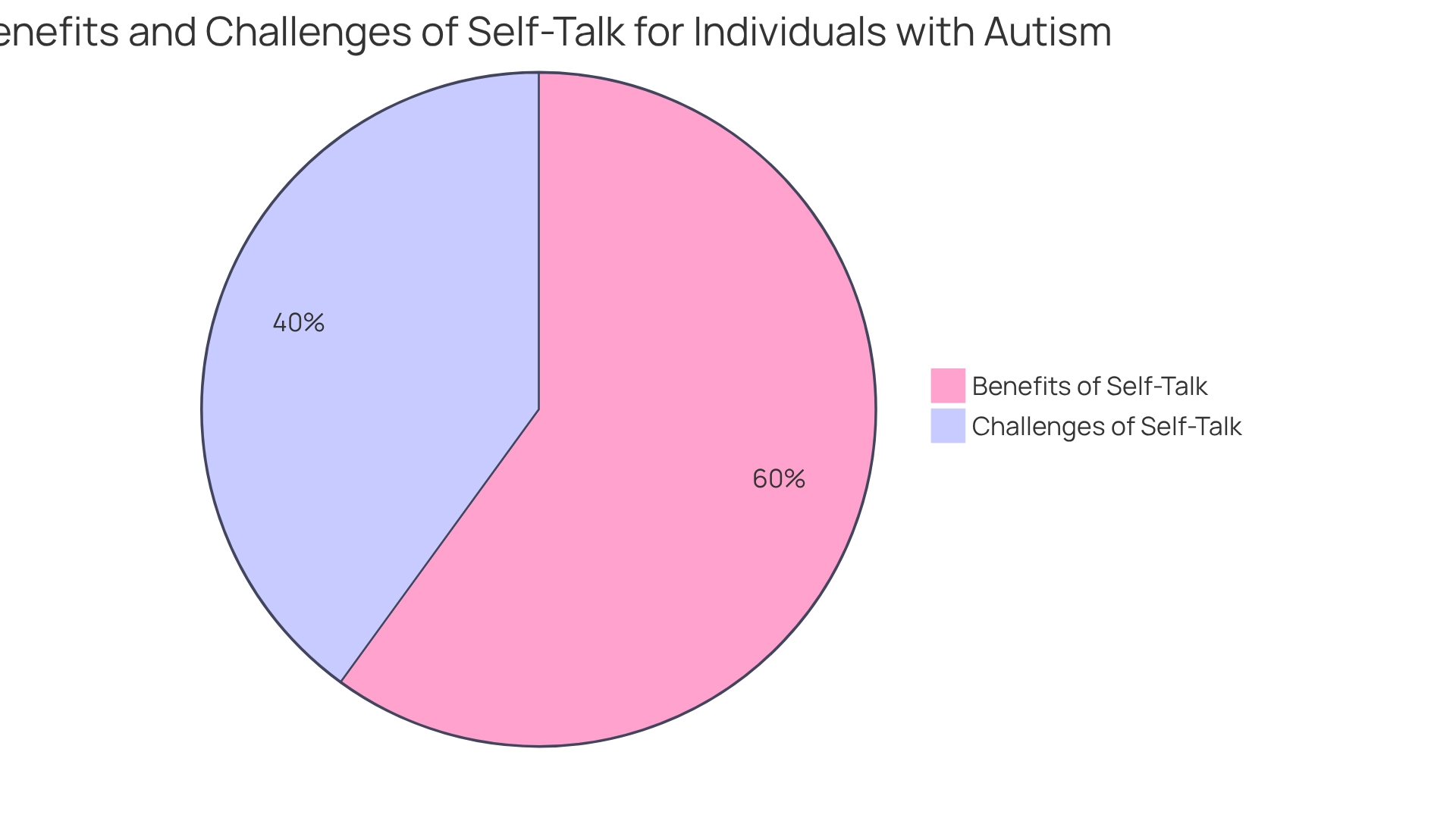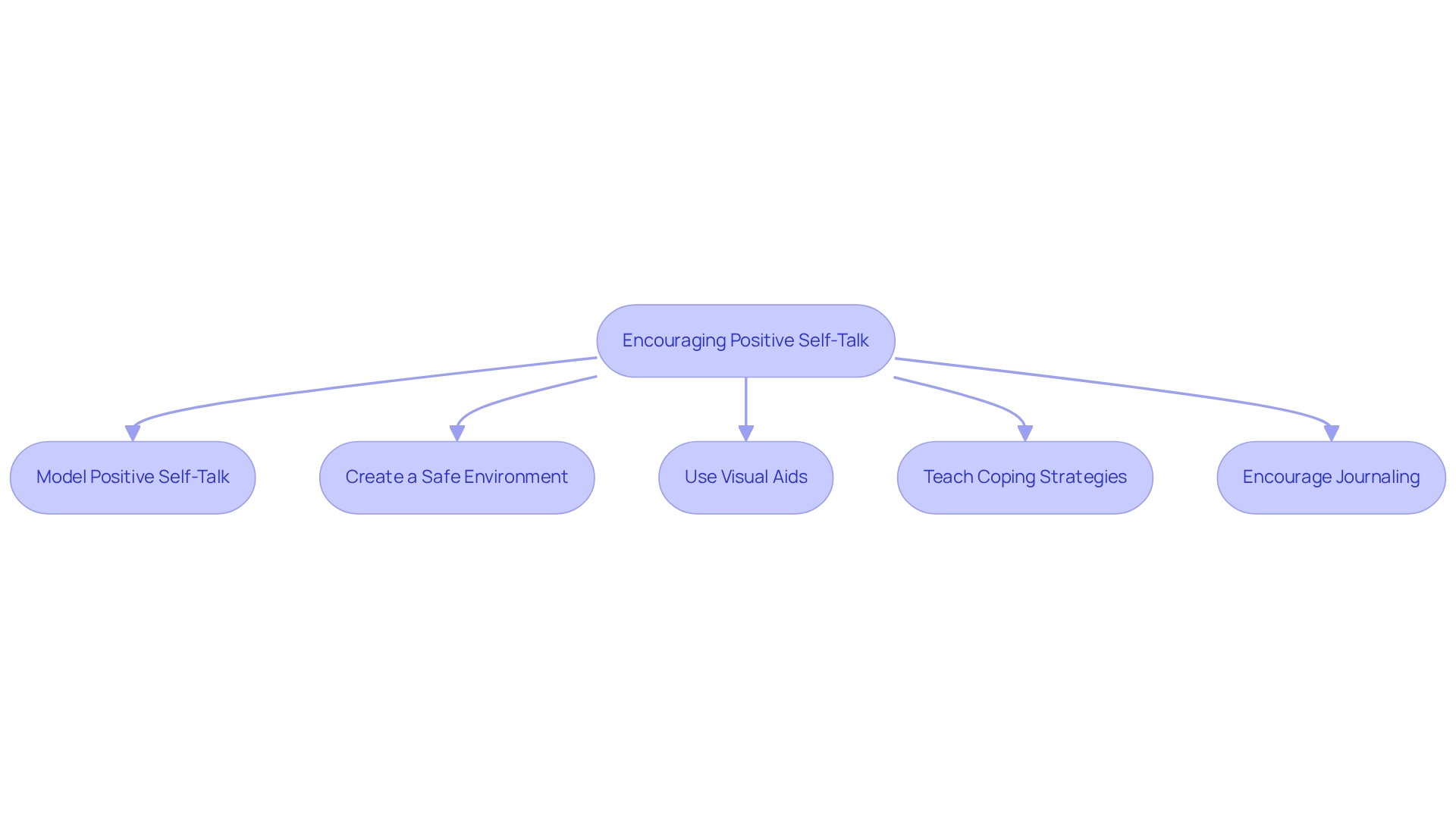Overview
This article highlights the incredible benefits and strategies related to self-talk for individuals with autism. Self-talk serves as a vital communication tool that not only aids emotional regulation but also supports cognitive processing. By understanding its significance, we can see how self-talk can alleviate anxiety and enhance problem-solving skills, which is so crucial for navigating daily challenges.
However, it’s important to recognize that there can be hurdles along the way, such as negative inner dialogue and social misunderstandings. These challenges remind us of the need for supportive strategies that encourage positive self-talk. By fostering an environment where individuals feel safe to express themselves, we can help them develop healthier thought patterns.
As we explore these strategies, let’s consider how we can share our experiences and support one another. What has worked for you or your loved ones? Together, we can create a nurturing community that empowers individuals with autism to thrive through the power of self-talk.
Introduction
In the intricate landscape of autism, self-talk emerges as a powerful yet often misunderstood phenomenon. This internal dialogue, whether expressed silently or aloud, plays a crucial role in helping individuals navigate their thoughts and emotions. It can provide comfort in times of stress and enhance cognitive processing, serving as a vital communication tool that fosters understanding and self-awareness.
However, while self-talk offers numerous benefits, it can also present challenges that impact social interactions and emotional health. Exploring the multifaceted nature of self-talk reveals its significance in the lives of those on the autism spectrum. This highlights the need for supportive strategies that encourage positive self-dialogue.
As we delve deeper, let us consider how these insights can empower individuals and their families, fostering a nurturing environment where self-talk can thrive.
Define Self-Talk in Autism: Understanding the Basics
Self-talk is the internal dialogue that many engage in, whether expressed silently or aloud. For those with neurodevelopmental conditions, this internal conversation can take various forms, such as:
- Repeating phrases
- Narrating actions
- Sharing thoughts
It's important to recognize that this phenomenon is not merely a quirk; for many autistic individuals, autism talking to self acts as a vital communication tool, helping them navigate their experiences and emotions. Understanding inner dialogue, especially in the context of autism talking to self, is essential as it sheds light on the potential benefits and challenges faced by individuals on the autism spectrum. By fostering this understanding, we can better support those who rely on self-talk as a means of processing their world.

Explore Reasons for Self-Talk: Emotional and Cognitive Insights
Self-talk plays a vital role for individuals with developmental differences. Emotionally, it serves as a comforting coping mechanism, helping to alleviate anxiety and stress by providing a way to articulate feelings. Imagine a child expressing their emotions aloud, finding solace in their own words.
Cognitively, this internal dialogue assists in organizing thoughts, enhancing problem-solving skills, and facilitating decision-making. For many, it becomes a lifeline to navigate overwhelming sensory experiences, allowing them to make sense of their environment and emotions.
Understanding these reasons is essential for grasping the broader effects of self-talk, particularly autism talking to self, in individuals on the autism spectrum. By recognizing the power of self-talk, we can better support and empower those we care about.

Assess Benefits and Challenges of Self-Talk in Autism
Self-talk, often referred to as autism talking to self, can be a powerful tool for individuals with autism, offering numerous benefits such as enhanced emotional regulation, improved cognitive processing, and a greater sense of self-awareness. By articulating their thoughts and feelings, individuals can foster better communication and social interactions, which is so important for building relationships.
However, it’s essential to recognize that challenges may also arise. Negative inner dialogue can sometimes creep in, amplifying feelings of anxiety or low self-esteem. Additionally, personal dialogue may be misunderstood by others, leading to feelings of social isolation or stigma.
Understanding both the advantages and potential pitfalls of self-talk is crucial for creating a nurturing environment. By acknowledging these dynamics, we can work together to provide the support that individuals with autism talking to self need in order to thrive.

Implement Strategies to Encourage Positive Self-Talk
To foster constructive inner dialogue in individuals with autism, consider these nurturing strategies:
-
Model Positive Self-Talk: Demonstrate healthy self-dialogue in everyday situations. This allows individuals to observe and learn from your example.
-
Create a Safe Environment: Cultivate an accepting atmosphere where self-expression is encouraged. This helps reduce the fear of judgment and promotes openness.
-
Use Visual Aids: Incorporate visual reminders or affirmations that inspire positive thinking. These aids can serve as constant encouragement.
-
Teach Coping Strategies: Provide resources that empower individuals to confront negative perceptions and replace them with positive self-dialogue. This equips them with essential tools for emotional resilience.
-
Encourage Journaling: Suggest maintaining a journal to articulate thoughts and feelings. This practice can aid in processing emotions and enhancing self-awareness.
By implementing these caring strategies, parents and professionals can significantly enhance the emotional and cognitive well-being of individuals with autism. Together, we can create a supportive journey towards self-discovery and positive growth.

Conclusion
Self-talk serves as a vital bridge between emotions and cognitive processes for individuals on the autism spectrum. By exploring the nature of self-talk, its emotional and cognitive benefits, and the challenges it may present, we can appreciate its significance in their lives. This inner dialogue not only aids in emotional regulation and enhances communication but also helps navigate the often overwhelming world around them.
While the benefits of self-talk are numerous, it is equally important to recognize potential pitfalls, such as negative self-dialogue and social misunderstandings. Creating an environment that nurtures positive self-talk is essential for fostering self-awareness and emotional resilience. Strategies like modeling healthy dialogue, using visual aids, and encouraging journaling can empower individuals to harness self-talk as a tool for growth and understanding.
Ultimately, acknowledging the multifaceted role of self-talk in autism underscores the need for compassionate support and proactive strategies. By nurturing positive self-dialogue, families and caregivers can help individuals on the autism spectrum thrive, transforming self-talk from a misunderstood phenomenon into a powerful ally for personal development and emotional well-being. Let us commit to fostering this supportive environment, ensuring that every individual has the opportunity to flourish.
Frequently Asked Questions
What is self-talk?
Self-talk is the internal dialogue that individuals engage in, which can be expressed silently or aloud.
How does self-talk manifest for individuals with neurodevelopmental conditions?
For those with neurodevelopmental conditions, self-talk can take various forms, including repeating phrases, narrating actions, and sharing thoughts.
Why is self-talk important for autistic individuals?
Self-talk serves as a vital communication tool for many autistic individuals, helping them navigate their experiences and emotions.
What are the potential benefits of understanding self-talk in autism?
Understanding self-talk, particularly in the context of autism, can shed light on the benefits and challenges faced by individuals on the autism spectrum, ultimately aiding in better support for those who rely on it to process their world.




